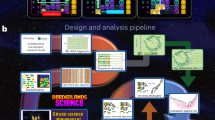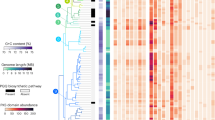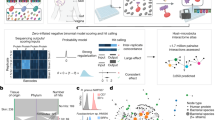Abstract
Microorganisms engage in complex interactions with other organisms and their environment. Recent studies have shown that these interactions are not limited to the exchange of electron donors. Most microorganisms are auxotrophs, thus relying on external nutrients for growth, including the exchange of amino acids and vitamins. Currently, we lack a deeper understanding of auxotrophies in microorganisms and how nutrient requirements differ between different strains and different environments. In this Opinion article, we describe how the study of auxotrophies and nutrient requirements among members of complex communities will enable new insights into community composition and assembly. Understanding this complex network over space and time is crucial for developing strategies to interrogate and shape microbial communities.
This is a preview of subscription content, access via your institution
Access options
Access Nature and 54 other Nature Portfolio journals
Get Nature+, our best-value online-access subscription
$29.99 / 30 days
cancel any time
Subscribe to this journal
Receive 12 print issues and online access
$209.00 per year
only $17.42 per issue
Buy this article
- Purchase on Springer Link
- Instant access to full article PDF
Prices may be subject to local taxes which are calculated during checkout



Similar content being viewed by others
References
Little, A. E. F., Robinson, C. J., Peterson, S. B., Raffa, K. F. & Handelsman, J. Rules of engagement: Interspecies interactions that regulate microbial communities. Annu. Rev. Microbiol. 62, 375–401 (2008).
Mitri, S. & Richard Foster, K. The genotypic view of social interactions in microbial communities. Annu. Rev. Genet. 47, 247–273 (2013).
D’Souza, G. et al. Less is more: Selective advantages can explain the prevalent loss of biosynthetic genes in bacteria. Evolution 68, 2559–2570 (2014).
Yu, X., Walker, D. H., Liu, Y. & Zhang, L. Amino acid biosynthesis deficiency in bacteria associated with human and animal hosts. Infect. Genet. Evol. 9, 514–517 (2009).
Embree, M., Liu, J. K., Al-bassam, M. M. & Zengler, K. Networks of energetic and metabolic interactions define dynamics in microbial communities. Proc. Natl Acad. Sci. USA 112, 15450–15455 (2015).
Liu, Y.-F. et al. Metabolic capability and in situ activity of microorganisms in an oil reservoir. Microbiome 6, 5 (2018).
Rodionova, I. A. et al. Genomic distribution of B-vitamin auxotrophy and uptake transporters in environmental bacteria from the Chloroflexi phylum. Environ. Microbiol. Rep. 7, 204–210 (2015).
Croft, M. T., Lawrence, A. D., Raux-Deery, E., Warren, M. J. & Smith, A. G. Algae acquire vitamin B12 through a symbiotic relationship with bacteria. Nature 438, 90–93 (2005).
Wexler, A. G. & Goodman, A. L. An insider’s perspective: Bacteroides as a window into the microbiome. Nat. Microbiol. 2, 1–11 (2017).
Wyn-Jones, R. G. Ubiquinone deficiency in an auxotroph of Escherichia coli requiring 4-hydroxybenzoic acid. Biochem. J. 103, 714–719 (1967).
Gruss, A., Borezée-durant, E. & Lechardeur, D. in Advances in microbial physiology (ed. Poole, R. K.) 70–111 (Elsevier, 2012).
Nichols, D. et al. Short peptide induces an ‘Uncultivable’ microorganism to grow in vitro. Appl. Environ. Microbiol. 74, 4889–4897 (2008).
Onofrio, A. D. et al. Siderophores from neighboring organisms promote the growth of uncultured bacteria. Cell Chem. Biol. 17, 254–264 (2010).
Koppel, N., Rekdal, V. M. & Balskus, E. P. Chemical transformation of xenobiotics by the human gut microbiota. Microbiota 356, 1–11 (2017).
Morris, J. J., Kirkegaard, R., Szul, M. J., Johnson, Z. I. & Zinser, E. R. Facilitation of robust growth of Prochlorococcus colonies and dilute liquid cultures by ‘helper’ heterotrophic bacteria. Appl. Environ. Microbiol. 74, 4530–4534 (2008).
Germerodt, S. et al. Pervasive selection for cooperative cross-feeding in bacterial communities. PLoS Comput. Biol. 12, 1–21 (2016).
Harvey, E. & Heys, J. Quantifying the effects of the division of labor in metabolic pathways. J. Theor. Biol. 360, 222–242 (2014).
Verbruggen, E. et al. Spatial structure and interspecific cooperation: Theory and an empirical test using the mycorrhizal mutualism. Am. Nat. 179, E133–E146 (2012).
Kreft, J. Biofilms promote altruism. Microbiology 150, 2751–2760 (2004).
Guzmán, G. I. et al. Model-driven discovery of underground metabolic functions in Escherichia coli. Proc. Natl Acad. Sci. USA 112, 929–934 (2015).
Morris, B. E. L., Henneberger, R., Huber, H. & Moissl-eichinger, C. Microbial syntrophy: interaction for the common good. FEMS Microbiol. Rev. 37, 384–406 (2013).
Lin, L., Yu, Z. & Li, Y. Sequential batch thermophilic solid-state anaerobic digestion of lignocellulosic biomass via recirculating digestate as inoculum –part II: microbial diversity and succession. Bioresour. Technol. 241, 1027–1035 (2017).
Degnan, P. H., Taga, M. E. & Goodman, A. L. Vitamin B12 as a modulator of gut microbial ecology. Cell Metab. 20, 769–778 (2014).
Zilberman-schapira, G. et al. The gut microbiome in human immunodeficiency virus infection. BMC Med. 14, 1–11 (2016).
Rakoff-Nahoum, S., Foster, K. R. & Comstock, L. E. The evolution of cooperation within the gut microbiota. Nature 533, 255–259 (2016).
Lopez-Siles, M., Duncan, S. H., Garcia-Gil, L. J. & Martinez-Medina, M. Faecalibacterium prausnitzii: from microbiology to diagnostics and prognostics. ISME J. 11, 841–852 (2017).
Fischbach, M. A. & Sonnenburg, J. L. Eating for two: How metabolism establishes interspecies interactions in the gut. Cell Host Microbe 10, 336–347 (2011).
Rey, F. E. et al. Metabolic niche of a prominent sulfate-reducing human gut bacterium. Proc. Natl Acad. Sci. USA 110, 13582–13587 (2013).
Zengler, K. et al. Cultivating the uncultured. Proc. Natl Acad. Sci. USA 99, 15681–15686 (2002).
Oberhardt, M. A. et al. Harnessing the landscape of microbial culture media to predict new organism–media pairings. Nat. Commun. 6, 8493 (2015).
Romine, M. F., Rodionov, D. A., Maezato, Y., Osterman, A. L. & Nelson, W. C. Underlying mechanisms for syntrophic metabolism of essential enzyme cofactors in microbial communities. ISME 11, 1434–1446 (2017).
Hibberd, M. C. et al. The effects of micronutrient deficiencies on bacterial species from the human gut microbiota. Sci. Transl Med. 9, eaal4069 (2017).
Mee, M. T., Collins, J. J., Church, G. M. & Wang, H. H. Syntrophic exchange in synthetic microbial communities. Proc. Natl Acad. Sci. USA 111, E2149–E2156 (2014).
Mee, M. T. & Wang, H. H. Engineering ecosystems and synthetic ecologies. Mol. Biosyst. 8, 2470–2483 (2012).
Kaleta, C., Schäuble, S., Rinas, U. & Schuster, S. Metabolic costs of amino acid and protein production in Escherichia coli. Biotechnol. J. 8, 1105–1114 (2013).
Heizer, E. M. Jr et al. Amino acid cost and codon-usage biases in 6 prokaryotic genomes: a whole-genome analysis. Mol. Biol. Evol. 23, 1670–1680 (2004).
Zuñiga, C. et al. Predicting dynamic metabolic demands in the photosynthetic eukaryote Chlorella vulgaris. Plant Physiol. 176, 450–462 (2018).
Neis, E. P. J. G., Dejong, C. H. C. & Rensen, S. S. The role of microbial amino acid metabolism in host metabolism. Nutrients 7, 2930–2946 (2015).
Stackebrandt, E., Cummins, C. S. & Johnson, J. L. in The Prokaryotes (ed. Falkom, S.) 400–418 (Springer−Verlag, New York, 2006).
Burkovski, A. & Kramer, R. Bacterial amino acid transport proteins: occurrence, functions, and significance for biotechnological applications. Appl. Microbiol. Biotechnol. 58, 265–274 (2002).
Genee, H. J. et al. Functional mining of transporters using synthetic selections. Nat. Chem. Biol. 12, 1015–1022 (2016).
Rodionov, D. A. et al. A novel class of modular transporters for vitamins in Prokaryotes. J. Bacteriol. 191, 42–51 (2009).
Allen, R. H. & Stabler, S. P. Identification and quantitation of cobalamin and cobalamin analogues in human feces. Am. J. Clin. Nutr. 87, 1324–1335 (2008).
Seth, E. C. & Taga, M. E. Nutrient cross-feeding in the microbial world. Front. Microbiol. 5, 350 (2014).
Degnan, P. H., Barry, N. A., Mok, K. C., Taga, M. E. & Goodman, A. L. Human gut microbes use multiple transporters to distinguish vitamin B12 analogs and compete in the gut. Cell Host Microbe 15, 47–57 (2014).
Caporaso, J. G. et al. Moving pictures of the human microbiome. Genome Biol. 12, R50 (2011).
Gajer, P. et al. Temporal dynamics of the human vaginal microbiota. Sci. Transl Med. 4, 132ra52 (2012).
Merchant, S. S. & Helmann, J. D. Elemental economy: microbial strategies for optimizing growth in the face of nutrient limitation. Adv. Microb. Physiol. 60, 91–210 (2014).
Bren, A., Hart, Y., Dekel, E., Koster, D. & Alon, U. The last generation of bacterial growth in limiting nutrient. BMC Syst. Biol. 7, 27 (2013).
Shou, W., Ram, S. & Vilar, J. M. G. Synthetic cooperation in engineered yeast populations. Proc. Natl Acad. Sci. USA 104, 1877–1882 (2007).
Schink, B. Synergistic interactions in the microbial world. Antonie Van Leeuwenhoek 81, 257–261 (2002).
Jiang, X. et al. Impact of spatial organization on a novel auxotrophic interaction among soil microbes. Preprint at bioRxiv, 195339 (2017).
Harcombe, W. R. et al. Metabolic resource allocation in individual microbes determines ecosystem interactions and spatial dynamics. Cell 7, 1104–1115 (2010).
Thaiss, C. A. et al. Microbiota diurnal rhythmicity programs host transcriptome oscillations. Cell 167, 1495–1510 (2016).
Smits, S. A. et al. Seasonal cycling in the gut microbiome of the Hadza hunter-gatherers of Tanzania. Science 357, 802–806 (2017).
Greenhalgh, K., Meyer, K. M., Aagaard, K. M. & Wilmes, P. The human gut microbiome in health: establishment and resilience of microbiota over a lifetime. Environ. Microbiol. 18, 2103–2116 (2016).
Thaiss, C. A. et al. Persistent microbiome alterations modulate the rate of post-dieting weight regain. Nature 540, 544–551 (2016).
Sonnenburg, E. D. et al. Diet-induced extinctions in the gut microbiota compound over generations. Nature 529, 212–215 (2016).
Collins, J. et al. Dietary trehalose enhances virulence of epidemic Clostridium difficile. Nature 553, 291–294 (2018).
Kartal, B., Kuenen, J. G. & Van Loosdrecht, M. C. M. Sewage treatment with anammox. Science 328, 702–703 (2010).
Lawson, C. E. et al. Metabolic network analysis reveals microbial community interactions in anammox granules. Nat. Commun. 8, 15416 (2017).
Kumar, R. et al. Identification of donor microbe species that colonize and persist long term in the recipient after fecal transplant for recurrent Clostridium difficile. Biofilms Microbiomes 3, 1–12 (2017).
Cuskin, F. et al. Human gut Bacteroidetes can utilize yeast mannan through a selfish mechanism. Nature 517, 165–169 (2016).
Lee, S. M. et al. Bacterial colonization factors control specificity and stability of the gut microbiota. Nature 501, 426–429 (2013).
Riddle, M. S. & Connor, B. A. The traveling microbiome. Curr. Infect. Dis. Rep. 18, 29 (2016).
Coyte, K. Z., Schluter, J. & Foster, K. R. The ecology of the microbiome: Networks, competition, and stability. Science 350, 663–666 (2015).
Sommer, F., Anderson, J. M., Bharti, R., Raes, J. & Rosenstiel, P. The resilience of the intestinal microbiota influences health and disease. Nat. Rev. Microbiol. 15, 630–638 (2017).
Gunderson, L. H. Ecological resilience - In theory and application. Annu. Rev. Ecol. Syst. 31, 425–439 (2000).
Hoek, T. A. et al. Resource availability modulates the cooperative and competitive nature of a microbial cross-feeding mutualism. PLoS Biol. 14, e1002540 (2016).
Köpke, M., Straub, M. & Dürre, P. Clostridium difficile is an autotrophic bacterial pathogen. PLoS ONE 8, e62157 (2013).
Byrd, A. L. et al. Staphylococcus aureus and Staphylococcus epidermidis strain diversity underlying pediatric atopic dermatitis. Sci. Transl Med. 9, eaal4651 (2017).
Nakatsuji, T. et al. Antimicrobials from human skin commensal bacteria protect against Staphylococcus aureus and are deficient in atopic dermatitis. Sci. Transl. Med. 9, eaah4680 (2017).
Bosi, E. et al. Comparative genome-scale modelling of Staphylococcus aureus strains identifies strain-specific metabolic capabilities linked to pathogenicity. Proc. Natl Acad. Sci. USA 113, E3801–E3809 (2016).
Ribet, D. & Cossart, P. How bacterial pathogens colonize their hosts and invade deeper tissues. Microbes Infect. 17, 173–183 (2015).
Byrd, B. A. L., Segre, J. A. & Koch, R. Adapting Koch’s postulates. Science 351, 224–226 (2016).
Franzosa, E. A. et al. Sequencing and beyond: integrating molecular ‘omics’ for microbial community profiling. Nat. Rev. Microbiol. 13, 360–372 (2015).
Parks, D. H. et al. Recovery of nearly 8,000 metagenome-assembled genomes substantially expands the tree of life. Nat. Microbiol. 2, 1533–1542 (2017).
Zuñiga, C., Zaramela, L. & Zengler, K. Elucidation of complexity and prediction of interactions in microbial communities. Microb. Biotechnol. 10, 1500–1522 (2017).
Markowitz, V. M. et al. IMG: the integrated microbial genomes database and comparative analysis system. Nucleic Acids Res. 40, 115–122 (2012).
Tan, J., Zuniga, C. & Zengler, K. Unraveling interactions in microbial communities — from co-cultures to microbiomes. J. Microbiol. 53, 295–305 (2015).
Caporaso, J. G. et al. QIIME allows analysis of high-throughput community sequencing data. Nat. Methods 7, 335–336 (2010).
Mallick, H. et al. Experimental design and quantitative analysis of microbial community multiomics. Genome Biol. 18, 228 (2017).
Turnbaugh, P. J. et al. The human microbiome project. Nature 449, 804–810 (2007).
Thompson, L. R. et al. A communal catalogue reveals Earth’s multiscale microbial diversity. Nature 551, 457 (2017).
Wang, M. et al. Sharing and community curation of mass spectrometry data with Global Natural Products Social Molecular Networking. Nat. Biotechnol. 34, 828–837 (2016).
Durot, M., Bourguignon, P. & Schachter, V. Genome-scale models of bacterial metabolism: reconstruction and applications. FEMS Microbiol. Rev. 33, 164–190 (2009).
Bordbar, A., Monk, J. M., King, Z. A. & Palsson, B. O. Constraint-based models predict metabolic and associated cellular functions. Nat. Rev. Genet. 15, 107–120 (2014).
Shoaie, S. et al. Quantifying diet-induced metabolic changes of the resource. Cell Metab. 22, 320–331 (2015).
Song, H.-S., Cannon, W., Beliaev, A. & Konopka, A. Mathematical modeling of microbial community dynamics: A methodological review. Processes 2, 711–752 (2014).
Xiao, Y. et al. Mapping the ecological networks of microbial communities. Nat. Commun. 8, 2042 (2017).
An, G., Mi, Q., Dutta-Moscato, J. & Vodovotz, Y. Agent-based models in translational systems biology. Wiley Interdiscip. Rev. Syst. Biol. Med. 1, 159–171 (2009).
Kaplan, H. & Hutkins, R. W. Metabolism of fructooligosaccharides by Lactobacillus paracasei 1195. Appl. Environ. Microbiol. 69, 2217–2222 (2003).
Thakur, K., Tomar, S. K. & De, S. Lactic acid bacteria as a cell factory for riboflavin production. Microb. Biotechnol. 9, 441–451 (2015).
Terwilliger, A. et al. Bacillus anthracis overcomes an amino acid auxotrophy by cleaving host serum proteins. J. Bacteriol. 197, 2400–2411 (2015).
Acknowledgements
Research in the authors’ laboratory was supported in part by the National Institute of Arthritis and Musculoskeletal and Skin Diseases of the National Institutes of Health under award number AR071731. The content is solely the responsibility of the authors and does not necessarily represent the official views of the National Institutes of Health. Work in the authors’ laboratory was also supported by the National Science Foundation under grant number 1332344 and the US Department of Energy, Office of Science, Office of Biological & Environmental Research Awards DE-SC0012586, DE-SC0012658 and DE-SC0018344.
Reviewer information
Nature Reviews Microbiology thanks Felix Sommer, Jan Roelof van der Meer and the other anonymous reviewer(s) for their contribution to the peer review of this work.
Author information
Authors and Affiliations
Contributions
K.Z. and L.S.Z. researched data for the article, made substantial contributions to discussions of the content, wrote the article and reviewed and edited the manuscript before submission.
Corresponding author
Ethics declarations
Competing interests
The authors declare no competing interests.
Additional information
Publisher’s note
Springer Nature remains neutral with regard to jurisdictional claims in published maps and institutional affiliations.
Rights and permissions
About this article
Cite this article
Zengler, K., Zaramela, L.S. The social network of microorganisms — how auxotrophies shape complex communities. Nat Rev Microbiol 16, 383–390 (2018). https://doi.org/10.1038/s41579-018-0004-5
Published:
Issue Date:
DOI: https://doi.org/10.1038/s41579-018-0004-5
This article is cited by
-
Genome-scale community modelling reveals conserved metabolic cross-feedings in epipelagic bacterioplankton communities
Nature Communications (2024)
-
Regulation of the PFK1 gene on the interspecies microbial competition behavior of Saccharomyces cerevisiae
Applied Microbiology and Biotechnology (2024)
-
Identifying vital spreaders in complex networks based on the interpretative structure model and improved Kshell
Computing (2024)
-
Ecological interactions and the underlying mechanism of anammox and denitrification across the anammox enrichment with eutrophic lake sediments
Microbiome (2023)
-
Coexistence of specialist and generalist species within mixed plastic derivative-utilizing microbial communities
Microbiome (2023)



